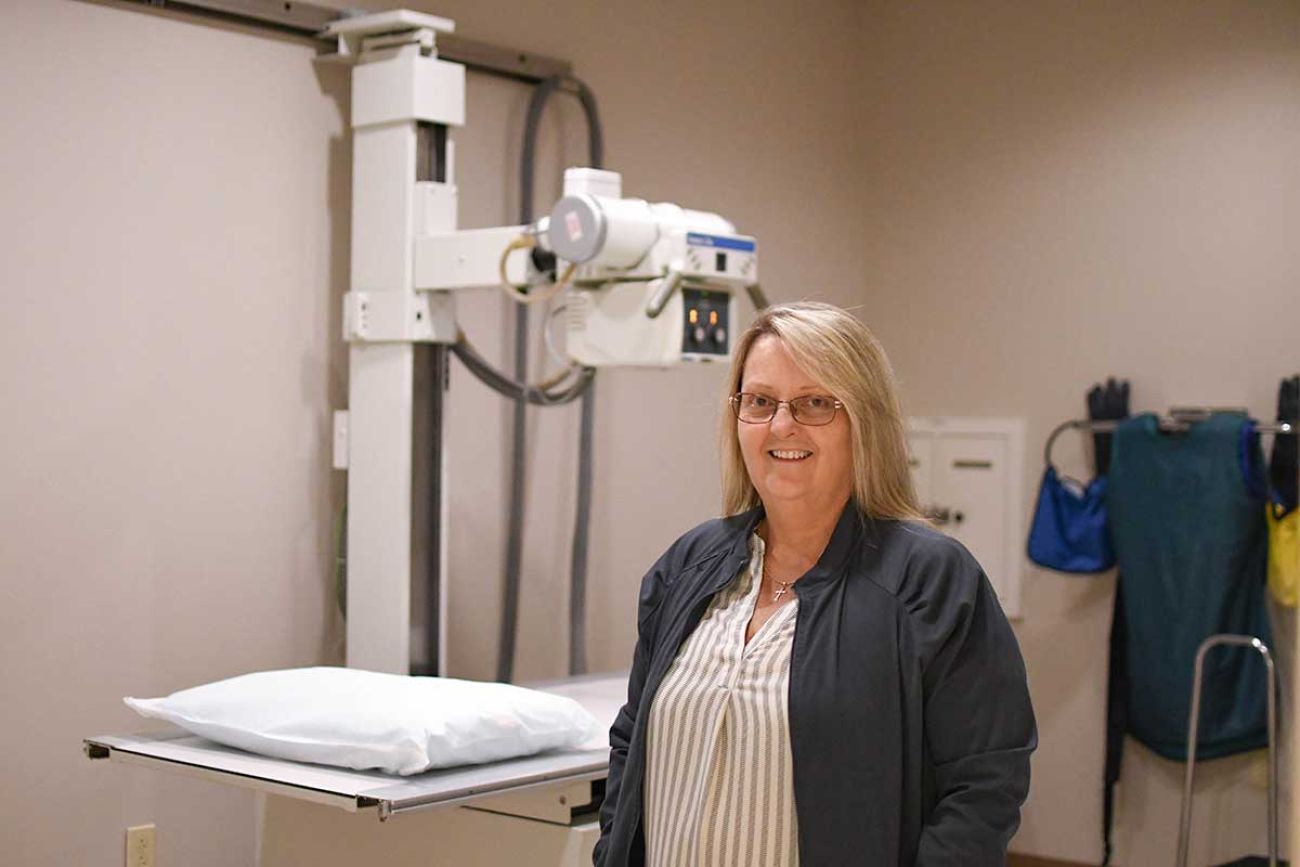Help wanted: Report ranks Michigan health care jobs with the most need

- Wracked by the need for more health care workers, Michigan’s hospitals and doctors’ offices say they’re having to trim back services and appointments.
- A new report clarifies the jobs in greatest need for both policymakers and job seekers.
There will always be sick people.
Her mother’s six-word advice set then-high schooler Kelly Parish on her career trajectory. Now if only the rest of Michigan would listen, the 56-year-old mused.
A radiologic technologist at Family Health Center in White Cloud in rural Michigan north of Grand Rapids, Parish finds purpose and even friendships in everyday appointments — whether it’s a teenager with a broken ankle, a worker with a wrenched back, or the fearful child who, staring at the x-ray machine, needs to be comforted, she said.
“I’ve never regretted it,” she said of her choice.
Parish represents one of dozens of health care roles that Michigan needs more people to consider — and fill — over the next ten years, according to a new report by the Michigan Healthcare Workforce Index.

According to the 66-page report, radiologic techs are one of the least needed positions. Yet even in that relatively stable field, the state will need nearly 4,000 new workers to fill demand over the next decade, authors note.
In other roles, the magnitude of shortages are “absurdly large,” said Michelle Wein, research director of the health care research nonprofit, Michigan Health Council, which published the report.
Related:
- Michigan health centers need medical staff. How one program is helping
- New psychiatric unit in northern Michigan to address severe care gap
- Michigan abortions for out-of-state patients jumped 66 percent last year
Consider: Michigan will need more than 170,000 home health aides, more than 67,000 registered nurses, 64,000 nursing assistants, 39,000 medical assistants, and 18,000 dental assistants in the next decade, according Wein’s research.
Also in great need are those with master’s of social work degrees to fill occupations that range from substance abuse counselors, marriage and family therapists, and mental health counselors. Michigan will need 27,000 more workers with that degree in the next decade, Wein concluded.
In fact, social workers were listed last year on Michigan’s “Hot 50” list of high demand, high wage careers through 2030. Pay ranges from about $19 to $30 an hour.
When it comes to health care, “nursing shortages have dominated the conversation since 2020, but all health care roles are in trouble,” she said.
In fact, Michigan has been wracked by health care workers shortages in recent years. Its hospitals have had to take more than 1,6000 beds offline because of shortages since October 2020, according to the Michigan Health & Hospital Association. As Bridge has previously reported, other shortfalls have forced cutbacks, for example, at psychiatric hospitals, nursing homes, and in personal care and at-home assistants who enable older Michiganders and those with disabilities to remain in their homes.
COVID created some shortages and sharpened others as burnout, safety concerns, a sense of disrespect brought on by angry patients, and long hours, prompted clinicians and support staff to switch fields or take early retirement. Michigan’s experience is a reflection of hospital staffing woes across the country.
“If you’re close to retirement and there’s a pandemic and you can afford to retire, you do it,” said Parish.
The “great resignation” might be slowing, replaced — as some have suggested — by the “big stay,” as few employees leave their jobs and employers post fewer openings. But Michigan’s pipeline is too narrow now to adequately fill tomorrow’s need.
The new report groups professions into 36 occupations from the “healthiest” to “unhealthiest” using four variables — growth of each profession over the next ten years, wage growth of each profession over the past decade, turnover rates within that profession, and the number of openings over the next ten years compared to the state’s ability to educate an adequate supply of those type of workers.
The calculus clarifies which professionals will demand the most people through 2032.
Among the “unhealthiest” professions, or those in the greatest need, will be medical assistants and dental assistants, based on the demand, the report found. At the opposite end of the need spectrum are nurse practitioners, meaning there are, at least relative to other health care professions, adequate numbers in the field.
Perhaps not surprisingly, among the jobs in greatest need are those that require less education and skill, but also pay less, noted Wein, who has been examining and refining the data since February.
Sometimes the “shortage” isn’t really a statewide shortfall; rather it’s that workers in some fields are concentrated in urban areas, leaving large stretches of the state without adequate health care coverage.
Guiding policy
Among the report’s other findings:
- Michigan will face health care workforce shortages in nearly every role between now and 2032
- Within those roles that do not appear to have “shortages,” there’s a “distribution problem” meaning the workers are lacking in rural areas.
- Occupations with fewer education requirements beyond a high school diploma continue to be in high need because of low wages.
- Mental health occupations – from community health workers to psychologists – face “immense” shortages
The data is not perfect, the authors note. For example, physicians are grouped together since information on subspecialities was not readily available, Wein said.
Still, the report offers more definitive data than before, and that can guide discussions for policymakers, employers and educators, she said.
“I’m hoping it sparks a conversation about these issues, including the distribution problems,” Wein said. “How do you solve that? How do you convince people to take jobs in areas that typically aren’t the most desirable?”
For example, it’s not just that some rural areas may have fewer amenities to draw workers, she said. It’s also that the shortage there means workers may be on call 24 hours.
The report will help decision makers strategize ways to bolster individual fields, said Kari Sederburg, vice president of programs and director of healthy aging efforts at the Brighton-based Michigan Health Endowment Fund, which funds health and wellness initiatives in Michigan and which funded the report.
“We know a lot of the broader challenges, this is the first step in their broader efforts,” Sederburg told Bridge Michigan.

The report also reinforced other critical deficits, such as the enormity of the shortage in home health care workers — the people who enable Michigan’s oldest residents and those with disabilities to remain living in their own homes. The turnover rate in those jobs, along with nursing assistants who provide crucial, everyday care in nursing homes, ranked the worst in turnover. More than 85 percent of home health and personal care aids and nursing assistants leave their position each year, according to the report.
A “pathway to build their career,” along with loan repayment programs and on-the-job training, may be among the solutions to keeping people within the field, Wein said.
A lack of awareness
Part of the effort to recruit more health care workers is simple awareness building, said Mike Salinas, a pharmacy tech at the Community Health and Social Services in Detroit. He’s worked at CHASS, a community health clinic, for more than five years, a job that he said gives him stability, purpose, and about $20 an hour — a dramatic pay bump from his previous job as a pharmacy tech elsewhere.
In fact, the average wage for a pharmacy tech in 2021 was $17.58, a jump of $4.59 from ten years earlier, according to the new report. And the state will need nearly 15,000 more pharmacy techs in the next decade, the report projects.
“The pay's getting better. The hours are good,” Salinas, the 50-year-old said.
“I think there’s a lack of knowing about the position. A lot of it has to do with stereotypes, too. A lot of guys don’t think of health care as a career. Most guys think you need to work construction or in a factory.”
In fact, Salinas left his position as a construction worker for the promise of more predictable hours. He was a pharmacy tech, he said, after just eight months of on-the-job training.
“It has been a good job, no doubt,” he said.
Low wages, high turnover
Although the report was written for policymakers and business leaders, it also maps out opportunities for job seekers or those considering a career switch.
For those needing a quick job, the report underscores, for example, that dental assistants and medical assistants were paid about $18 an hour in 2021 for those positions.
In comparison, for those considering higher education, a nurse anesthetist was paid about $106 in 2021 — nearly 2 ½ times the amount than a decade earlier.
Wein said the plan is to make the index dynamic, so that policy makers and job seekers can sort the data for their own needs to determine, for example, which jobs will experience the most growth, which have the highest turnover, and which pay the best, Wein said.
Depending on the need, “there are a lot of different ways to slice this data,” she said.
Michigan workers vacancies
In this occasional series, we examine the scope of critical worker shortages in 2023, from doctors and police officers to math teachers and social workers. To view more stories in this series click here.
See what new members are saying about why they donated to Bridge Michigan:
- “In order for this information to be accurate and unbiased it must be underwritten by its readers, not by special interests.” - Larry S.
- “Not many other media sources report on the topics Bridge does.” - Susan B.
- “Your journalism is outstanding and rare these days.” - Mark S.
If you want to ensure the future of nonpartisan, nonprofit Michigan journalism, please become a member today. You, too, will be asked why you donated and maybe we'll feature your quote next time!








